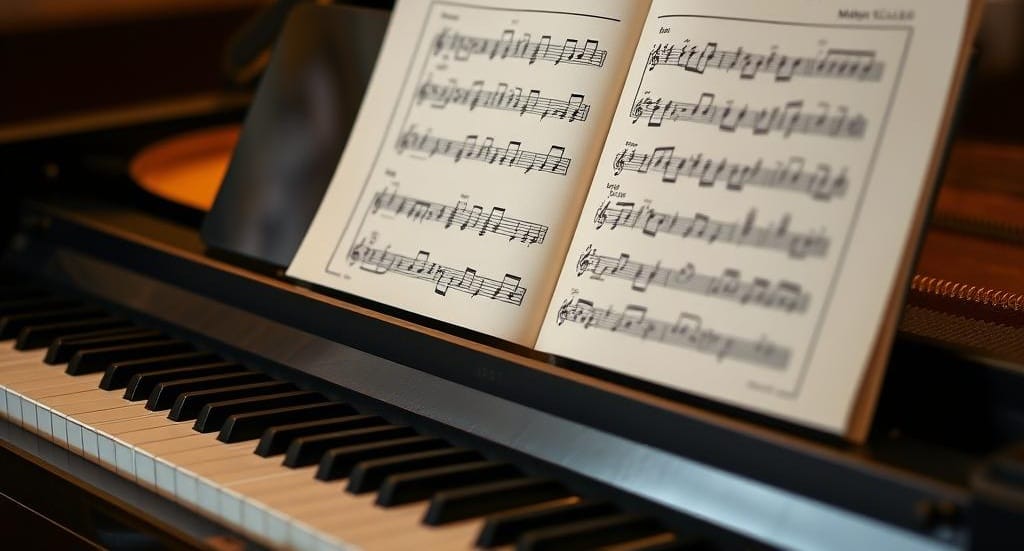Sing in Tune with Better Ear Training - Daily Drills
Ever wondered why some singers can hit any note easily while others struggle? It’s not about magic. It’s about a skill anyone can learn with practice.
Many think they need “perfect pitch” to play music well. But this belief stops many from trying. In truth, pitch recognition can be learned with regular practice.
Vocalists don’t have keys or frets like musicians do. They must rely on their inner hearing and muscle memory. This makes recognizing and accurately reproducing musical sounds very important for singers.
Improving your inner hearing is the first step to mastering music. It means training your brain to pick out intervals, chords, and melodies by ear. The great news? With practice, you can get much better at hearing and playing pitches.
For singers, this training is key. It helps them improvise, sing in harmony with others, and perform with confidence. Whether you’re just starting or have been singing for years, improving your skills will change your musical journey.
Understanding the Fundamentals of Musical Pitch

Musical pitch is key to singing well. It’s important to know the basics before you start training your ear. Learning about pitch helps you recognize and sing music better. It’s like having a map for your singing journey.
What Is Pitch in Music?
Pitch is how high or low a sound sounds to us. It’s linked to the sound wave’s frequency, measured in Hertz (Hz). The higher the frequency, the higher the pitch.
For singers, pitch is very personal. Unlike musicians with instruments, singers use their inner ear and voice to get the right pitch. Knowing pitch is very important.
Every musical note has its own pitch. The distance between notes forms melodies and harmonies. Singing a scale is like following a path of pitches that your brain learns over time.
The Difference Between Absolute and Relative Pitch
Absolute pitch and relative. Knowing the difference helps set goals for training. Perfect or absolute pitch lets you identify any note without a reference. It’s rare, found in less than 1 in 10,000 people.
Relative pitch lets you identify notes by comparing them to a known note. It’s more common and can be learned with practice. Having a good relative pitch ear is very useful.
With relative pitch, you can:
– Stay in key while singing
– Harmonize accurately with other vocalists
– Identify when you’re slightly sharp or flat
– Learn melodies more quickly by ear
While perfect pitch is the dream, relative pitch is more useful for most music. It’s the main focus for ear training in singing.
How Your Brain Processes Musical Sounds
From sound waves to your brain recognizing a pitch, it’s a complex journey. Knowing how it works helps you train your ear better.
Sound waves go through your outer ear to your middle ear. There, tiny bones vibrate. These vibrations then go to your inner ear, where they’re turned into signals your brain can understand.
Your brain maps these signals to specific pitches. The more you practice, the better your brain gets at recognizing these pitches.
Your brain doesn’t just look at individual pitches. It looks for patterns and relationships. This is why music context is so important.
Building a musical ear means training your brain through practice. Every time you get a pitch right, you’re strengthening your brain’s connections. This builds your understanding of music.
Studies show musicians’ brains are different from non-musicians. This shows how your brain can change and adapt. This means you can learn to recognize music better at any age, even if it takes longer for adults.
The Importance of Ear Training for Singers

Ear training is like a secret key for singers. It connects what you hear to what you can sing. Many singers focus on their technique or range. However, the real key to mastering your voice is how well you can listen to and understand sound.
When you see singers match pitches or create harmonies easily, it’s because of their listening skills. These skills work together with their vocal technique.
Ear training helps you identify and sing musical sounds. This includes notes, intervals, rhythms, and chord progressions. For singers, this skill is absolutely essential. Even the most talented voice can’t reach its full ability without it.
The Connection Between Hearing and Singing
Your voice can only make sounds you can hear. This is why ear training is essential for singers. Unlike instrumentalists, singers rely on hearing to guide their pitch.
When singing, your brain adjusts your voice based on what you hear. This happens very quickly. The better you listen, the more precise your singing will be.
Your brain connects hearing and singing more efficiently. Your ear becomes like a tuner for your voice.
Benefits for Vocal Performance and Musicianship
Ear training does more than just help you sing in tune. It improves many parts of your singing.
Improved pitch accuracy is a big win. You’ll hit notes more precisely and keep pitch steady. This builds confidence and lets you focus on expression.
Ear training also makes harmonizing easier. You’ll find your part in complex harmonies and keep it steady.
Your musicianship will grow as you learn rhythm, dynamics, and tone. You’ll sing more independently, which is useful in auditions and solo performances.
How Ear Training Enhances Musical Interpretation
Ear training changes how you understand and express music. As you get better at listening, you notice more. This deeper listening changes how you approach music:
You’ll feel the emotions of different sounds. For example, major thirds sound bright, while minor sevenths create tension. Knowing this helps you choose how to express a song’s message.
Ear training also helps you understand changes in music. You’ll navigate key changes with confidence. You’ll naturally emphasize important parts of the melody.
Ear training makes you freer in performance. When you trust your ear, you can connect with your audience more. This is where true artistry shines.
Ear training is not just for singing accurately. It changes how you listen, practice, and perform. For serious singers, it’s not optional—it’s essential.
Assessing Your Current Pitch Recognition Abilities
Knowing how well you can recognize pitches is key to bettering your ear. Before starting any practice, find out where you stand. This helps tailor your training to fit your needs.
Simple Self-Assessment Tests
There are easy tests to check your pitch recognition skills. Try matching a note played on a piano with your own singing. Record it to see how close you get.
Next, see if you can tell if two notes are higher or lower. Then, try naming the interval between them. Many online tools can help with these tests.
Another test is singing back a short melody. This shows how well you can follow musical patterns. It also tests your memory.
For a deeper check, see if you can tell different chord types by ear.
Identifying Your Strengths and Weaknesses
After these tests, look at your results to spot patterns. You might find you’re good at some things but not others. This helps you know where to focus.
Notice any common mistakes or areas where you struggle. This could be with certain intervals or in a specific range. Knowing this helps you target your training.
Also, think about your musical background. You might know theory, but struggle with singing pitches, if you’ve played an instrument but have not sung much.
Setting Realistic Training Goals
With a clear idea of your skills, you can set smart goals to improve your pitch recognition. Goals should be specific, measurable, achievable, relevant, and timely (SMART).
For example, aim to identify all major and minor thirds in two weeks. Or, try to improve your melodic dictation from 60% to 80% in 3 months or less.
Start with simple goals and gradually move to harder ones:
1. Begin with basic pitch matching if needed
2. Move to interval recognition, starting with easily distinguishable intervals
3. Progress to scale and mode identification
4. Advance to chord quality recognition
5. Develop melodic and harmonic dictation skills
Remember, ear training takes time. Don’t set goals that are too hard or too easy. Aim for consistent, daily practice.
Keep track of your progress with the same tests you used to start. This shows how far you’ve come and keeps you motivated. Many singers find it helpful to keep a journal of their ear training.
Understanding your current skills and setting smart goals, you can improve your pitch recognition. This personalized approach makes your training more effective for singing and music.
Developing Single Note Recognition

Learning to identify and sing individual pitches is important in ear training. You must start with single notes to master melodies and harmonies. This skill is the base for all ear training and helps you sing in tune.
Basic Pitch Matching Exercises
Begin with simple pitch-matching exercises in your vocal range. Play a note and then sing it back. Hold the note for a few seconds to match it exactly.
Try the “find and sustain” method. Play a note, then:
1. Think of the pitch
2. Sing the note naturally
Use a tuner app for visual feedback in basic ear training exercises. It shows how close you are to the pitch. Practice for 5-10 minutes daily, focusing on accuracy.
Call-and-Response Techniques
Call-and-response is great for beginners. It’s a musical conversation that builds your ear. Here’s how it works:
Have someone sing or play a short phrase. Then, sing it back exactly. Start with 2-3 notes and add more as you get better.
This method has many benefits:
• It connects what you hear to what you sing
• It improves your musical memory
• It makes you better at matching pitch
• It enhances your tonal awareness
Practice with different voices and instruments. This trains your ear to recognize single notes in various sounds.
Progressive Training Methods
As you get better at pitch matching, try harder exercises. A structured approach helps you progress without getting overwhelmed.
Here are some ways to improve:
1. Octave jumps: Match notes an octave apart. This helps you recognize notes in different registers.
2. Random note sequences: Practice with random notes. Apps like Perfect Ear and Ear Master are great for this.
3. Timbre variations: Match pitches from different instruments and voices. This focuses on the fundamental pitch.
4. Pitch memory drills: Play a note, then wait 5-10 seconds before singing it. Increase the wait time to improve your pitch memory.
Consistency is key in call-and-response exercises. Even 10-15 minutes daily is better than longer sessions now and then. Record your practice to track your progress.
Remember, improving single note recognition takes time. Be patient and celebrate small victories. Each correct pitch you match strengthens your ear training skills.
Mastering Interval Recognition

Interval recognition is important for singers wanting to improve their skills. It helps you understand melodies, harmonies, and music structure.
Understanding Musical Intervals
A musical interval is the space between two notes. Intervals are like building blocks for melodies and harmonies. Each interval has a size and quality, like major or minor.
Intervals are divided into two types. Melodic intervals are when notes follow each other. Harmonic intervals happen when notes play together. Both are important for singers.
The smallest interval is the half step. Larger intervals, like the perfect fifth and octave, make bigger jumps. Learning to tell apart similar-sounding intervals is basic ear training.
Exercises for Identifying Intervals
Start with easy intervals like perfect fifths and octaves. These sound good and are easy to spot. Play them on a piano or use an app, then sing them back.
Practice in steps. Start with two intervals and add more as you get better. Try to identify intervals played by someone else.
Practice both going up and down. Descending intervals are harder, so focus on them.
Just 10-15 minutes a day can really help.
Try interval chains. Sing a note, then follow an interval direction. This improves your skills in recognizing and singing intervals.
Memorizing Interval Relationships Through Songs
Link each interval to a song you know. This makes it easier to remember intervals. For example, “Somewhere Over the Rainbow” starts with an octave leap.
Here are some song-interval pairs to help you remember:
- Minor Second: Theme from “Jaws” or “Pink Panther”
- Major Second: Beginning of “Happy Birthday”
- Minor Third: First two notes of “Greensleeves”
- Major Third: First two notes of “When the Saints Go Marching In”
- Perfect Fourth: Beginning of “Here Comes the Bride”
- Tritone: Opening of “The Simpsons” theme
- Perfect Fifth: First two notes of “Star Wars” theme
- Major Sixth: First two notes of “My Bonnie Lies Over the Ocean”
- Minor Seventh: First two notes of “Star Trek” theme
- Octave: Beginning of “Somewhere Over the Rainbow”
Make your own list of songs for intervals. Use songs you love. This makes learning intervals more fun.
As you practice, think about how intervals work in music. Notice how some create tension and others resolve it. This deeper understanding will make you a better musician.
Interval recognition is a useful skill. It helps with sight-singing, improvisation, and learning new music. Spending time on intervals will improve your music skills in many ways.
Training Your Ear for Scales and Modes
Learning to recognize scales and modes opens up a new world for singers. It lets you quickly spot different scales and modes. This skill makes it easier to move through music smoothly.
It helps you stay in tune, improvise better, understand music more deeply, and feel the emotions in the music more clearly.
Major and Minor Scale Recognition
Learning to tell major from minor scales is the first step. Major scales sound bright and uplifting. Minor scales, on the other hand, feel sad or tense.
Listen to the C major and C minor scales on the piano. They sound very different, even though they start the same. The major scale feels complete, while the minor scale feels more serious.
To get better at minor scales, practice identifying the three types: natural, harmonic, and melodic. Natural minor follows the key signature. Harmonic minor raises the seventh scale degree. Melodic minor raises the sixth and seventh degrees when going up, but goes back to natural minor when going down.
Try singing a random major or minor scale without looking. Identify if it’s major or minor and which type of minor it is. Keep track of how well you do as you get better.
Modal Ear Training Techniques
After mastering major and minor scales, learn the seven diatonic modes. Each mode has its own sound, which is found in many musical traditions.
Start by comparing each mode to a major scale. For example, Dorian mode is like a major scale but with a lowered third and seventh. Lydian mode has a raised fourth degree, making it sound bright and unique.
Make a routine to listen to each mode from the same starting note. Focus on the special intervals that make each mode sound different. Phrygian mode, for example, has a half-step between the first and second degrees, giving it a Spanish or Middle Eastern feel.
Link each mode to songs you know. Dorian is in “Scarborough Fair,” Mixolydian is in “Sweet Home Alabama,” and Lydian is in “The Simpsons” theme. These connections help you recognize modal sounds in new music.
Singing Scales to Internalize Patterns
Singing scales is key to really understanding them. When you sing a scale, you build muscle memory. This connects what you hear with what you sing.
Add singing scales to your daily warm-up. Start with major scales using solfège syllables or scale degree numbers. This helps you understand each note’s role in the scale.
Then, sing scales in different patterns, not just up and down. Try singing in thirds or with rhythmic changes. This makes your brain more flexible with scale knowledge.
Improvise melodies within each scale or mode. Start simple and then use more notes. This makes learning scales fun and boosts your musical instincts.
Record yourself singing scales and listen back. Focus on keeping your pitch right, but pay extra attention to transitions. These areas often show where you need to improve.
With regular practice, you will quickly recognize and sing any scale or mode. This skill improves your sight-reading, improvisation, and overall music ability. You’ll feel more confident and free in your music.
Chord and Harmony Recognition

Learning to identify chords and harmonies by ear makes your singing richer. Many singers just focus on the melody. But knowing harmonies lets you connect deeper with music’s emotions.
This skill is great for singing in groups, improvising, or working with accompanists. It helps you keep pitch right, even when the key changes. You’ll also get better at finding harmony parts on your own.
Identifying Basic Chord Types
Harmony in Western music starts with triads – three-note chords. There are four basic triad types: major, minor, diminished, and augmented. Each has a unique sound you can learn to recognize.
Major chords sound bright and finished. Minor chords are darker and sadder. Diminished chords feel tense and anxious. Augmented chords sound otherworldly, often signaling a change in music.
To make these triads, start with a root note (like C). Then add the third and fifth notes above it. The intervals between these notes tell you the chord type. For example, a C major triad is C, E, and G. A C minor triad is C, E♭, and G. Learning these differences is important for chord recognition.
Recognizing Chord Progressions
After identifying chords, learn how they work together in chord progressions. Many progressions are used across genres, from classical to pop. Knowing these helps you stay on pitch and improve your musical interpretation.
Start with the I-IV-V progression, used in many songs. In C major, this is C-F-G. Other important ones include the ii-V-I (Dm-G-C) in jazz and the I-V-vi-IV (C-G-Am-F) in pop.
Listen to songs you know well to learn these patterns. Try to spot when the harmony shifts and name the chord function. This practice sharpens your ability to hear music’s harmonic structure.
Exercises for Harmonic Ear Training
Improving your harmonic ear needs regular practice with specific exercises. Start with arpeggiated chord singing. Sing each note of a chord in order, then guess the chord type. This connects your voice to your harmonic understanding.
Another good exercise is identifying the bass note in chords. Listen to music and focus on the lowest note in each chord. The bass line often shows the chord progression. Sing along with the bass line of songs you know.
For a challenge, try the “missing note” exercise. Play a chord but leave out one note. Then sing the missing note. This exercise helps your brain fill in harmonic gaps and improves your chord understanding.
Group practice also helps your harmonic ear. Sing different parts of a chord with friends or other singers. This makes learning fun and helps you hear your part in a harmonic context.
Remember, harmonic ear training builds on skills you’ve already developed. The more you practice, the better you’ll get at complex music.
Melodic Dictation and Reproduction
Learning to reproduce melodies by ear is key for singers. It lets you remember and sing back melodies you hear. This skill uses all the ear training you’ve learned so far.
Techniques for Remembering Melodies
Remembering melodies by ear needs special mental tricks. Chunking breaks down long melodies into smaller parts. This makes it easier for your brain to remember.
Look for patterns in the melody. Most melodies have predictable patterns and repeated parts. These patterns help you remember the melody better.
Find “landmark notes” in the melody. These are notes that stand out because of their position or length. They help you remember the melody by acting as anchors.
Imagine the melody moving up and down as you sing it. Drawing the melody in the air helps connect sound and shape in your brain.
Singing Back Simple to Complex Phrases
Start with simple melodies. Begin with short patterns that move by step. Practice singing them back right away, focusing on pitch and rhythm.
As you get better, try more complex melodies. Progressive challenge helps you grow without getting stuck. Each success builds your confidence.
Try singing a short phrase after hearing it. Start with simple melodies and add more notes and rhythms as you improve. Record yourself to see how you are progressing.
Use the “add-a-note” method. Start with one note, then add another. Keep adding notes until you’ve got the whole melody. This strengthens your memory with each step.
Developing Your Musical Memory
Spaced repetition is great for long-term memory. Practice in short, focused sessions throughout the day.
Listen to a melody, then wait a bit before singing it back. Start with short waits and get longer as you get better. This tests your memory.
Visualize the melody after hearing it. Close your eyes and replay it before singing. This strengthens the connection between hearing and singing.
Link melodies to emotions. Our brains remember better when tied to feelings. Notice how melodies make you feel, and use these feelings to help remember.
Improving your ear training through melodic dictation has many benefits. You’ll learn songs faster, need less sheet music, and feel more confident in improvisation. These skills are great for solo performances and singing with others.
Building strong melodic memory takes time and regular practice. Even a few minutes a day can make a big difference. Being able to sing back melodies by ear is a rewarding skill from your training.
Effective Tools and Resources for Ear Training

Finding the right ear training tools can be tough. But the right ones can really help you get better at recognizing pitches. Today, singers have many tools to choose from. These range from new apps to old-school methods.
It’s important to pick tools that fit your learning style. This keeps you motivated and helps your progress.
Ear Training Apps and Software
Digital tools have changed how singers train their ears. Ear training apps offer fun exercises with instant feedback. This is something old methods can’t do.
EarMaster is a top choice for its wide range of exercises. It starts with simple pitch matching and goes up to complex harmonies.
Ear Master is great for its easy-to-use design and adjustable levels. It helps you improve in areas like recognizing intervals or singing melodies. Tenuto, for Apple users, has cool tools that link what you hear to music theory.
When picking an ear trainer app, think about what you want to improve. Some apps are better for intervals, others for chords or singing.
But remember, apps should help, not replace, playing music. Practice with apps for 10-15 minutes a day. Then, use what you learned in real music.
Check out the EarMaster – Ear Training App to learn more!
Online Courses and Programs
Ear training courses offer a structured way to improve your listening. Berklee Online has college-level courses taught by famous music teachers. These courses mix ear training with music theory.
The Vocalist Studio uses videos and exercises with feedback from mentors. His courses link ear training to songwriting and performance.
Many vocal coaches offer online ear training programs. They help singers deal with the challenges of translating what they hear into song.
When looking at online programs, check if they:
- Have exercises that match your skill level
- Give feedback on your accuracy
- Have a community for support
- Connect with other music skills
- Help with performance
Books and Traditional Methods
Even with new tech, old ear training methods are very effective. The Kodály method uses solfège syllables to teach note relationships. It has helped many musicians for years.
“Ear Training for the Contemporary Musician” is a classic book. It offers a step-by-step way to improve your ear without tech. It includes audio examples to go with the exercises.
Reading music while listening to recordings helps a lot. It connects what you see and hear. This strengthens your ear and music reading skills at the same time.
Traditional methods build a strong music theory base. Knowing music theory helps you recognize notes better over time.
The best singers mix tech, courses, and traditional methods. This balanced approach helps you develop a strong ear for music.
Consistency is key, no matter what tools you use. Practice for at least 10-15 minutes a day and record yourself often to see how you’re doing. Listen to different music to improve your ear.
Integrating Ear Training into Your Daily Practice
Mastering pitch recognition is not about long practice sessions. It’s about making ear training a part of your daily routine. Like learning a new language, it needs consistent practice, not just occasional cramming. Many singers struggle because they see ear training as separate from their regular practice.
Research shows that 10-15 minutes of daily practice can improve pitch-matching skills in 3-4 weeks. It’s not about how long you practice, but how often and how well you do it.
Creating a Consistent Training Schedule
Having a regular ear training routine is important for lasting pitch recognition skills. Consistent practice strengthens neural connections in your brain. Short daily sessions are more effective than long weekly ones.
Find times in your day for 10-15 minutes of training. Attach them to your daily habits, like practicing interval recognition while making coffee. Or do pitch-matching exercises before your vocal warm-up.
Keep a practice journal or use a digital tracker to see your progress. Recording your daily achievements motivates you. Remember, consistent practice leads to faster improvement.
Short, Focused Practice Sessions
Quality beats quantity in ear training. Your brain learns better in short, focused bursts. This is why 10-15 minute sessions are more effective than longer ones.
Make your practice sessions goal-oriented, not time-based. Spend five minutes on interval recognition, five on chord identification, and five on melodic dictation. This approach helps you make progress in different areas.
Use the principle of progressive overload in your practical exercises. Start with easy material, then move to harder stuff. End with something fun, like singing a favorite song while focusing on pitch.
Combining Ear Training with Other Vocal Exercises
The best way to improve your ear is to mix pitch recognition with your vocal exercises. This saves time and helps you apply what you learn right away. It strengthens the connection between hearing and singing.
Begin your warm-up with simple pitch-matching exercises. Play a note, then match it with your voice. Gradually add more complex patterns. This primes your voice and ear for better practice.
Turn standard scale exercises into ear training by listening before singing. Sing scales without accompaniment, then check your accuracy. This improves your relative pitch and tonal center without proper training.
When working on repertoire, analyze the melody and harmony. Identify tough intervals or progressions and practice them. This improves your musical understanding and singing accuracy.
The goal of ear training is to enhance your musicianship. By integrating ear training into your daily practice, you’ll become more confident and expressive in your singing.
Overcoming Common Ear Training Challenges
Training your ear for pitch recognition is a journey with ups and downs. Many singers face hurdles, but these are normal steps in learning. They show you’re on the right path, not that you lack musical talent.
Dealing with Pitch Matching Difficulties
This can be tough due to physical or mental reasons. Some singers have trouble because their vocal muscles are not developed. Others struggle because their brain doesn’t process music well.
Try this simple exercise to improve: play a note, listen, then sing “ah” to match it. Record yourself and compare. Start with notes in the middle before moving to higher or lower ones.
Physical factors like tension or poor breath support can affect your pitch. Regular warm-ups can help relax your voice and improve pitch matching.
Psychological barriers like anxiety or self-doubt can also hinder your pitch. Practice in a calm, judgment-free space.
Remember, developing your ear takes time, and mistakes are learning chances.
Breaking Through Training Plateaus
Plateaus happen when you feel like you’re not getting better, even with practice. They’re common and can be frustrating if you don’t understand them.
When you hit a plateau, don’t keep doing the same thing. Try new exercises or change how you practice familiar ones. If you’ve been using piano sounds, try different instruments or voices.
Make your practice more challenging by adding new intervals or recognizing them in chord progressions. This will help you grow.
Use your skills in new ways. Practice ear training with music you don’t usually listen to. This challenges your brain and helps you break through plateaus.
From Training to Performance: Applying Your Ear Skills on Stage
Stepping on stage is the real test of your ear training. All those hours spent on relative pitch pay off. You’ll see a big difference in how you work with other musicians.
Strong aural skills help you sing in tune, even in tough places. If the band changes key or tempo, you can adjust easily. This lets you focus on expressing yourself, not just hitting the right notes.
Harmonizing gets better with ear training. You can create great vocal lines on the spot, making performances richer. Many singers say ear training helps them improvise better.
Playing by ear becomes easy as you get better. You learn new songs quickly and adjust them to fit your voice. In groups, you connect better with others, making music tighter.
Ear training is a big investment for singers. It takes you from practice to stage, improving your skills and musical identity. Your ears guide every note, making your singing precise and artistic.
Improve your Singing in 30 Days

Join Our Singing Community
Become a part of the Singing Community and gain access to exclusive resources and expert guidance on vocal techniques. Whether you’re a beginner or a seasoned performer, our community offers support and inspiration to help you reach your vocal potential.

